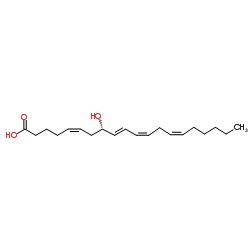8(s)-hete

8(s)-hete structure
|
Common Name | 8(s)-hete | ||
|---|---|---|---|---|
| CAS Number | 98462-03-4 | Molecular Weight | 320.466 | |
| Density | 1.0±0.1 g/cm3 | Boiling Point | 471.1±45.0 °C at 760 mmHg | |
| Molecular Formula | C20H32O3 | Melting Point | N/A | |
| MSDS | USA | Flash Point | 252.8±25.2 °C | |
| Symbol |


GHS02, GHS07 |
Signal Word | Danger | |
|
HMDB: a knowledgebase for the human metabolome.
Nucleic Acids Res. 37(Database issue) , D603-10, (2009) The Human Metabolome Database (HMDB, http://www.hmdb.ca) is a richly annotated resource that is designed to address the broad needs of biochemists, clinical chemists, physicians, medical geneticists, nutritionists and members of the metabolomics community. Si... |
|
|
The human serum metabolome.
PLoS ONE 6(2) , e16957, (2011) Continuing improvements in analytical technology along with an increased interest in performing comprehensive, quantitative metabolic profiling, is leading to increased interest pressures within the metabolomics community to develop centralized metabolite ref... |
|
|
Lipidomics reveals a remarkable diversity of lipids in human plasma.
J. Lipid Res. 51(11) , 3299-305, (2010) The focus of the present study was to define the human plasma lipidome and to establish novel analytical methodologies to quantify the large spectrum of plasma lipids. Partial lipid analysis is now a regular part of every patient's blood test and physicians r... |
|
|
Simultaneous quantification of leukotrienes and hydroxyeicosatetraenoic acids in cell culture medium using liquid chromatography/tandem mass spectrometry.
Biomed. Chromatogr. 29 , 1084-93, (2015) Leukotrienes (LTs) and hydroxyeicosatetraenoic acids (HETEs) are important bioactive lipid mediators that participate in various pathophysiological processes. To advance understanding of the mechanisms that regulate these mediators in physiological and pathol... |
|
|
A targeted lipidomics approach to the study of eicosanoid release in synovial joints.
Arthritis. Res. Ther. 13 , R123, (2011) Articular tissues are capable of producing a range of eicosanoid mediators, each of which has individual biological effects and may be affected by anti-inflammatory treatment. We set out to develop and evaluate a high performance liquid chromatography-tandem ... |
|
|
Differential activation of peroxisome proliferator-activated receptors by eicosanoids.
J. Biol. Chem. 270 , 23975-23983, (1995) Peroxisome proliferator-activated receptors (PPARs) are nuclear hormone receptors that regulate gene transcription in response to peroxisome proliferators and fatty acids. PPARs also play an important role in the regulation of adipocyte differentiation. It is... |
|
|
8(S)-hydroxyeicosatetraenoic acid is the lipoxygenase metabolite of arachidonic acid that regulates epithelial cell migration in the rat cornea.
Cornea 19 , S13-S20, (2000) We previously found that the inhibition of lipoxygenases resulted in delayed epithelial wound closure in organ-cultured rat corneas. The present study was undertaken to determine the lipoxygenase enzyme and metabolite(s) responsible for regulating reepithelia... |
|
|
Expression of peroxisome proliferator-activated receptors in urinary tract of rabbits and humans.
Am. J. Physiol. 273 , F1013-F1022, (1997) Peroxisome proliferator-activated receptors (PPARs, alpha, beta/delta, and gamma) are members of the nuclear receptor superfamily of ligand-activated transcription factors. PPARs regulate the expression of genes involved in lipid metabolism. 8(S)-hydroxyeicos... |